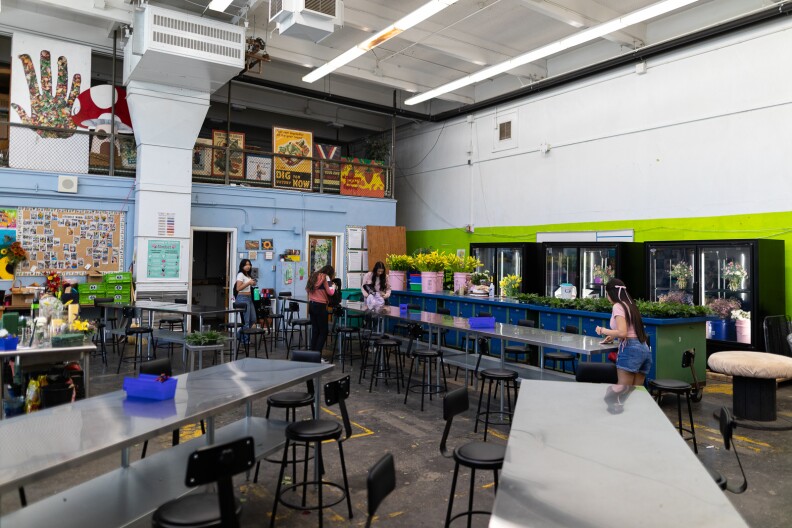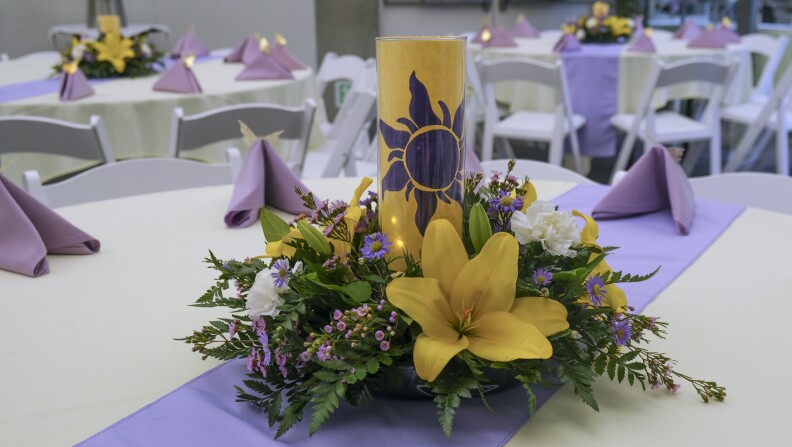Inside The School Gardening Program Where Students Grow All The Flowers For Prom

The week before prom is crunch time for Sylmar Charter High School's floriculture students.
On Wednesday, students poke green foliage — lemon and leather leaf — into foam rings that have been soaked in water.
Senior Jamie Hernandez walks out to the garden to pluck green and white pittosporum leaves for her prom date’s boutonniere.
“Personally, I view it as it looks more elegant,” she says. Hernandez contemplates whether weaving in the twisting tendrils of the sweet pea will match the theme’s inspiration: Tangled, Disney’s 2010 reinterpretation of Rapunzel.
“It's really [the students’] vision and we're just trying to help them achieve it,” says floriculture teacher Araceli Aguilar.
Floriculture, the growing and care of ornamental plants, is part of an agriculture program that dates to the school’s opening in 1961. The class blends science, sustainability, financial literacy, and creativity. Students said the high-ceilinged classroom also holds a sense of calm that’s hard to find on a high school campus.
“In other classes you're stressed because you're taking an exam,” says senior Salvador Garcia. “If you've ever, like, grabbed the flower, it's really relaxing to actually bond with them.”
Students ‘at peace with all the nature’
Long stems of lilies — their buds closed tightly like unripened bananas — sit in pink buckets at the back of the classroom.
“You think they're going to pop open by Friday?” Aguilar asks. The response is a hopeful “Yeah!”
Valeria Villalbazo threads wire through small creamy white roses for her corsage.
“A lot of people usually buy their own and it's, like, more expensive,” Villalbazo says. “I have the skills to make my own.”
An estimated 1,000 varieties of native plants, vegetables, flowers, and fruit trees — there are 15 varieties of apples alone — grow at Sylmar Charter High School.
“I tell the kids that there is something to eat in this garden every single day of the year,” says horticulture teacher Steve List, who started at the school in 2006.
The bulk of the two-acre horticulture program is tucked into the southeast corner of campus. A mural featuring Xochipili, the Aztec god of flowers, monarch butterflies, and a hummingbird marks the entrance.
Bees buzz between the blooms of more than a half dozen varieties of lavender, white sage, and holy basil growing nearby.
“If I ever feel overwhelmed… I know I could go into the garden and be at peace with all the nature and all the flowers,” says senior Nathan Poor.
Research shows growing up with access to green space is associated with better mental health in adulthood. Parents and students have pressed for more vegetation and shade at L.A. schools as temperatures increase.
List says agricultural classes were once common throughout the Los Angeles Unified School District; now just 17 schools have dedicated programs.
Sylmar students grow plants from seed in the green house, harvest fresh vegetables and turn compost. In one area, a student has arranged pots of beans around a pole with twine leading up to the center so the crawling vines create a canopy as they grow.
-
In addition to what’s grown at the school, Aguilar said the class and the school’s environmental club count on local vendors to donate “less than perfect” blooms for the raw material her class uses to create their assignments. Local nurseries also support the school’s agriculture program with donations of soil and plants. Contact Aguilar about the floriculture program and Steve List about the horticulture program.
“We try and give the kids as much control over the space as we can,” says horticulture teaching assistant Stefan Strong, himself an alum of the program.
The school relies on donations of seedlings, soil, and other supplies. The resulting produce and plants are incorporated into the school’s culinary arts program and distributed throughout the community.
“A lot of people put energy into us,” Strong says. “The least we can do is put it back out.”
Connecting to the San Fernando Valley’s agricultural past
One of the first lessons in floriculture is plant identification or what Aguilar calls “what grows in your hood?”
They visit the olive trees (olea europea) that grow on the school’s campus, a homage to the time Sylmar was one of the world’s largest olive producers.
The students harvest the leaves and create olive crowns.
Historian Jean-Paul deGuzman says there’s value in connecting the students to the history of the land their school sits on.
“The local is their entry point to understanding the complexities of global events, of economic reconfigurations, and even the migrations that might have brought their families to this place,” he says.

Other projects include bouquets, garlands, a Día De Los Muertos altar, and arrangements for school events from homecoming to graduation. The capstone project for the advanced class is a mock wedding held in the school’s garden. Students are responsible for every detail from the invitations to centerpieces.
The floral industry is notoriously wasteful — most flowers are imported and many are wrapped in single-use plastics.
Aguilar teaches her students more sustainable practices, including diverting scraps from the trash into the school’s compost program and creating arrangements with recycled materials like wine bottles and native plants.
“I just feel like I value the flowers more now that I've taken the class and I've gotten to learn more about them,” senior Valeria Villalbazo says.

The students also learn how to price and market their arrangements.
“You want to give homie hookups? That's up to you,” Aguilar tells her students. “Think of it as an hour of your time. ‘How much are you going to pay for an hour of your time?’”
Aguilar says students have started their own side hustles using the skills from her class.
“This is adulting 101,” Aguilar says. “You get to learn these skills before you go out into the real world.”
For some students, classes build on their personal histories.
Garcia, who grew up in Mexico near San Juan del Río, Durango, remembers his grandmother would send him to her home garden to collect plants for herbal remedies and teas.
During the pandemic, Garcia started a succulent collection with plants from the San Fernando swap meet. He said the class has deepened his knowledge of soil and growing season.
“It's made my garden be better than before I had this class,” Garcia says.
Teacher leads with her journey

Aguilar started at Sylmar Charter High in 2008 as a special education assistant. She helped students with disabilities throughout the school day, including in the school’s horticulture program where she picked up enough skills that she started designing florals for weddings and events.
Aguilar says the detailed work of corsages, boutonnieres and floral jewelry is a way to practice mindfulness.
“I'm just creating and making something beautiful,” Aguilar says. “I don't realize that time is going by because I'm in the moment.”
Aguilar battles anxiety. She doesn’t share details, but said it’s the product of a childhood where she didn’t feel supported. She practiced yoga, ran, and meditated, but realized she needed more help to manage her anxiety and sought out a therapist.
“Sometimes we get overwhelmed by the big picture,” Aguilar says. “But you need to break it down a little bit at a time.”
To help center her students, Aguilar asks the students in her beginner floral class to write down an affirmation before they get to work each day.

Aguilar’s daughter was born when she was 17, her son, three years later. She earned an associate’s degree while raising her children and working as a bilingual classroom assistant.
“I never thought I was going to teach,” Aguilar says.
Among the requirements to become a certificated educator in California are a bachelor’s degree, a preparation program and at least 600 hours of student teaching. But the state offers an exception for certain technical classes, and Aguilar’s experience in floral design qualified her for a specific credential to teach agricultural classes.
“I'm proud of myself because I did something I thought I would never do,” Aguilar says. Her eyes well with tears when she talks about her journey from teaching assistant to teacher.
One of her next long-term goals is to complete a bachelor’s degree. Potentially in sustainability.
“It's going to be little baby steps, but I'll get there,” Aguilar says. “I might be 60 by the time I'm done, but you know, I'll get it.”
‘At last we see the [prom] night’
On the night of prom the lilies have opened into bright yellow stars. Fairy lights twinkle from the lanterns, hand stenciled by the student government to match the sun pattern from the Disney movie.
In all, Aguilar and the students have created 36 centerpieces, 12 bouquets for the prom court, boutonnières, and corsages for themselves and school administrators.

Salvador Garcia arrives in a black suit, purple tie and Doc Marten oxfords laced with white ribbon.
“I feel like it brings my personality out,” Garcia says.
The white rose in his boutonniere has unfurled and the petals sparkle with glitter— he plans to save it for the memories.
Valeria Villalbazo’s white spray rose corsage is accented by green and white pittosporum leaves from the high school’s garden.
“Ay, that is cute,” her friend exclaims. “It goes with her dress very well.”
Aguilar, wearing a ring and earrings with fresh flowers, greets the students with “how handsomes” and “que bonitas.”
She stops to help Alexander Noriega pin the boutonniere he made in her class to the lapel of his black suit jacket.
“I think it turned out great,” Noriega says of the white rose surrounded by delicate baby’s breath. “I loved making it. It was really fun and I love how I look at the end.”
He signed up for floriculture on a whim and has used his skills to make arrangements for his friends and his mom.
“When she picks me up and she sees me carrying a flower, I see her get excited,” Noriega says. “It's the most precious thing I think I've ever seen.”
-
Sandhill cranes are returning to the Lake Tahoe basin after a century long hiatus in what many say is a conservation success story.
-
Jackie’s partner, Shadow, refuses to abandon their unviable eggs, despite her attempts to nudge him along.
-
We do have some of the same types of buildings here.
-
Switching to an electric heat pump water heater can save you money and help the state avoid power outages.
-
The state's parks department is working with stakeholders, including the military, to rebuild the San Onofre road, but no timeline has been given.
-
Built in 1951, the glass-walled chapel is one of L.A.’s few national historic landmarks. This isn’t the first time it has been damaged by landslides.
















